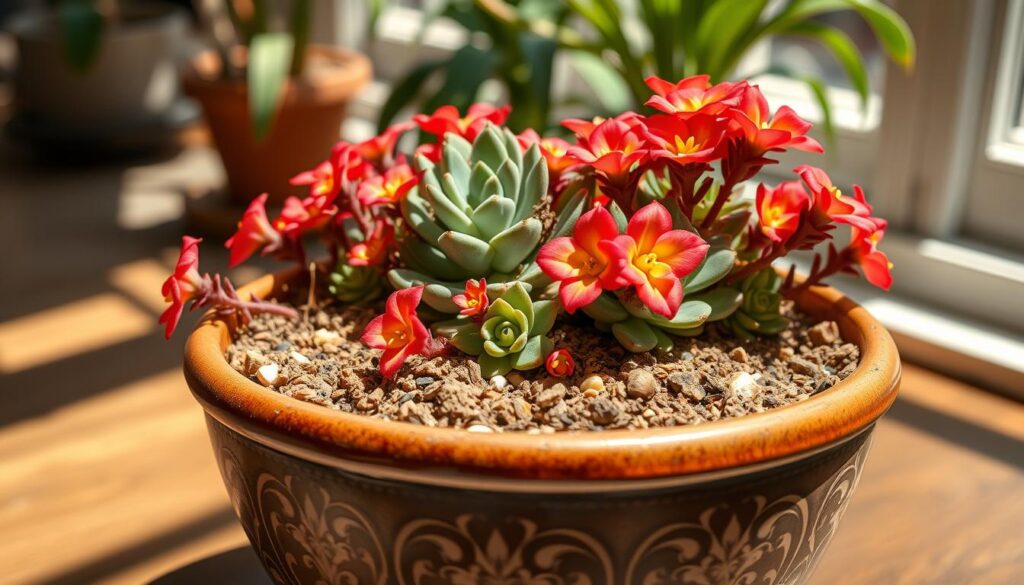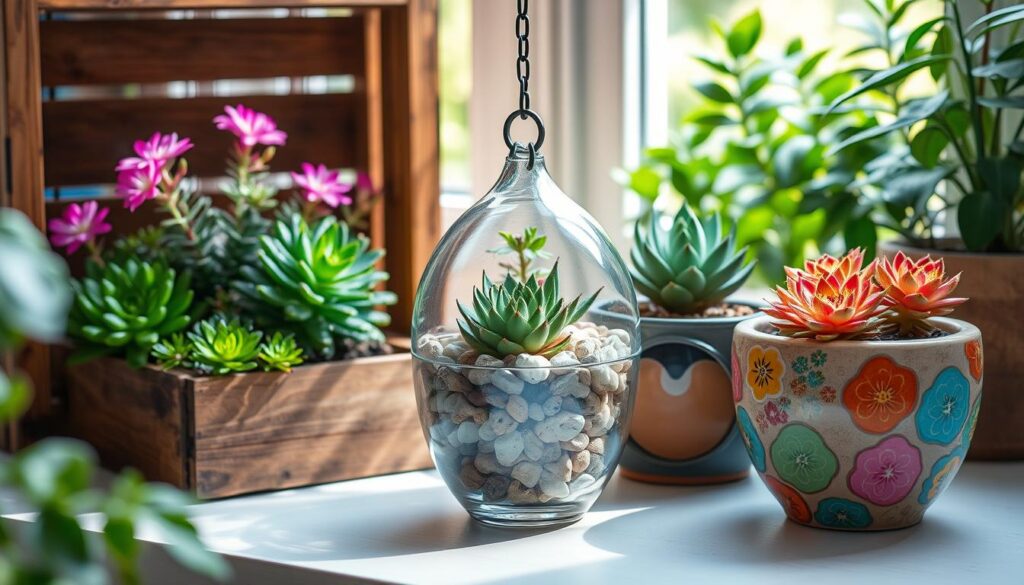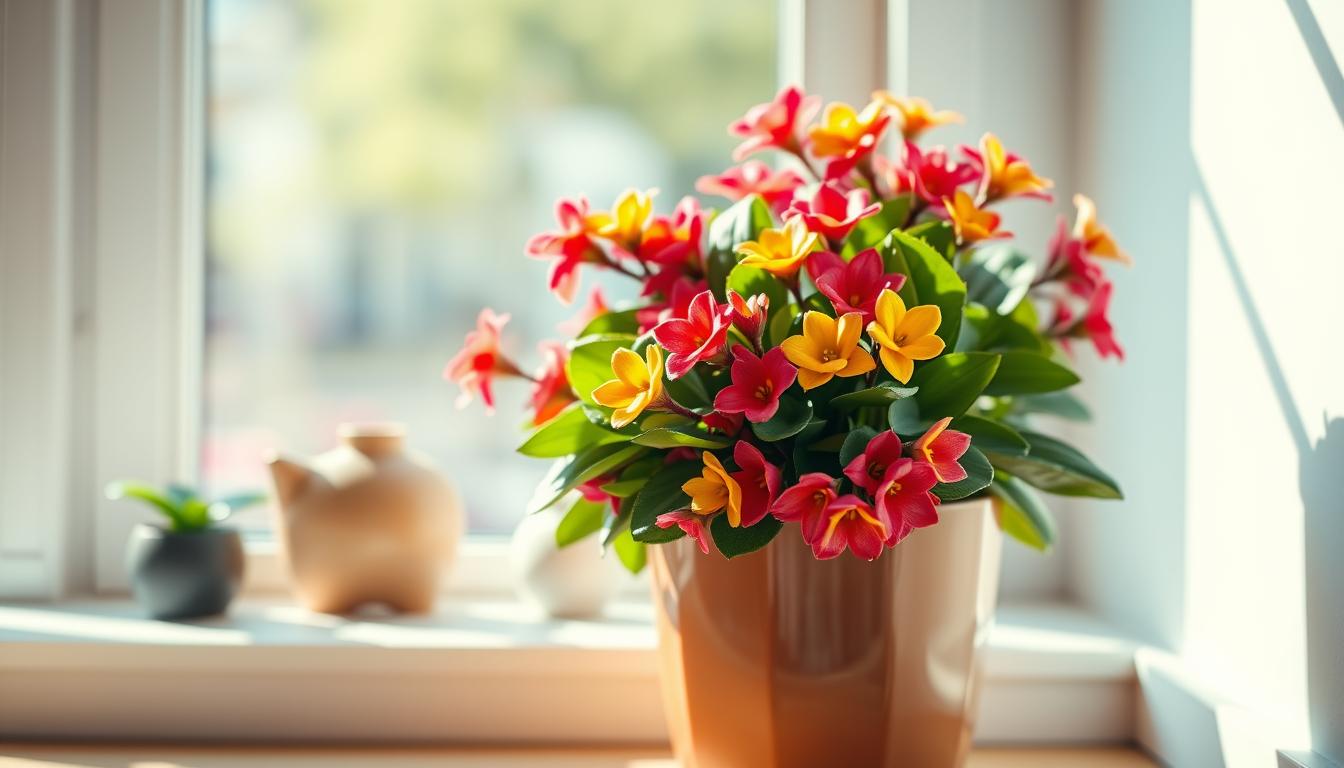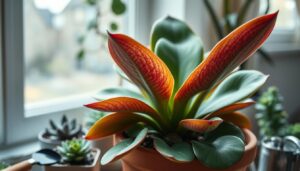Introduction to the Vibrant World of Kalanchoe
Kalanchoe is a plant that’s easy to care for and looks great. It comes from Madagascar and loves tough places. This makes it perfect for inside your home. There are many types of Kalanchoe, like Kalanchoe blossfeldiana and Calandiva. They bloom for weeks, showing off colors like red and pink. They’re great for homes because they’re easy to take care of.Origins and Natural Habitat
Kalanchoe comes from Madagascar. It’s good at surviving in different places. Knowing where it comes from helps you take better care of it at home.Popular Kalanchoe Species for Home Growing
Kalanchoe blossfeldiana, Calandiva, and Grandiva are favorites for homes. They bloom brightly and don’t need much care. With the right care, they’ll brighten your space for weeks.Why Choose Kalanchoe for Your Indoor Space
Kalanchoe is great for homes because it cleans the air and is easy to care for. It comes in many colors and blooms for a long time. Choosing the right Kalanchoe can make your home more beautiful and healthy.Essential Light and Temperature Requirements
For your Kalanchoe indoor plant to grow well, it needs the right light and temperature. Kalanchoe plants need 6-8 hours of light each day. They do best in east-facing windows for soft morning sun. The temperature is also very important. Kalanchoe plants like temperatures between 60°F and 85°F. A cooler night can help them grow even better. Here are some important tips for your Kalanchoe indoor plant:- Ideal temperature range: 60°F to 85°F
- Night temperature drop: 10-15°F
- Importance of consistency: Avoid temperature changes
| Temperature Range | Effects on Kalanchoe Plant |
|---|---|
| Below 60°F | Stunted growth, leaf drop |
| 60°F to 85°F | Optimal growth, healthy blooming |
| Above 85°F | Wilting, heat stress |
Mastering Kalanchoe Watering Techniques
Learning about Kalanchoe care is key. Knowing how to water your Kalanchoe right is very important. It keeps the plant healthy and stops root rot. Water your Kalanchoe well, but let the soil dry out before you water again. This stops root rot. But, if you don’t water enough, the leaves might shrivel. Think about the humidity in your home when caring for your Kalanchoe. It likes average humidity. Don’t mist it too much, as this can cause fungus. Here are some tips for the best Kalanchoe care:- Water your Kalanchoe once a week, letting the soil dry out first.
- Check the soil moisture by sticking your finger into the soil up to the first knuckle.
- Avoid getting water on the leaves to prevent fungal diseases.
| Watering Frequency | Soil Moisture | Humidity Levels |
|---|---|---|
| Once a week | Dry between waterings | Average indoor humidity |
Soil and Potting Guidelines for Healthy Growth
Choosing the right soil for Kalanchoe is key. Look for a mix made for succulents and cacti. This mix stops water from making the soil soggy. It helps your roots grow strong. A mix of 60% peat moss and 40% perlite works great. It keeps the soil moist but drains well. The soil’s pH should be between 5.5 and 6.5. This lets your plant soak up nutrients well. You can use a mix made for cacti or make your own with compost, perlite, and pumice. Check the soil’s pH often. This keeps it just right for your plant.| Soil Component | Percentage | Benefits |
|---|---|---|
| Peat Moss | 60% | Moisture retention |
| Perlite | 40% | Drainage |
| Organic Compost | Varies | Nutrient enrichment |

The Secret to Continuous Kalanchoe Blooms
To keep Kalanchoe flowers blooming, you need to know how they grow. Give them 12 to 14 hours of dark each day. This helps them get ready to bloom and grow. When they rest, water them less, about every three weeks. Keep their home warm, above 50°F (10°C). This helps them bloom better. In fall, give them low light to help them make more flowers.- Providing 14 hours of lightless conditions to promote budding
- Reducing watering and fertilization during the winter months
- Pruning about 3 to 25% of the top growth to maintain fullness and prevent legginess
| Season | Care Adjustments |
|---|---|
| Winter | Reduce watering and fertilization |
| Summer | Provide 8 hours of sunlight daily |
| Fall | Provide low light conditions to encourage flower formation |
Kalanchoe Propagation Methods Made Simple
It’s easy to grow more Kalanchoe plants. You can use leaf or stem cuttings. First, take a 2-3 inch stem cutting from a healthy plant. Make sure it has at least two leaves. For more tips, check out trusted houseplant guides. Let the cutting dry for a few days. This helps prevent disease and rot. Then, plant it in a mix that drains well, like 2:1 peat moss to sand. Keep the soil moist but not too wet to avoid root rot. Use regular misting to keep the soil right. Here are some tips for successful Kalanchoe propagation:- Use a cutting that is 2-3 inches long with at least two leaves.
- Allow the cutting to callous for a few days before planting.
- Plant the cutting in a well-draining soil mix.
- Keep the soil moist but not waterlogged.
Preventing and Treating Common Kalanchoe Problems
When you care for your Kalanchoe, you might face some common problems. Regular inspections help find issues early, like Kalanchoe pests and Kalanchoe diseases. Pests like aphids, mealybugs, and spider mites can harm your plant. To keep pests away, ensure good air flow, don’t overwater, and use a draining soil mix. Organic insecticides, like neem oil, can help if pests show up. Kalanchoe diseases like Phytophthora rot, powdery mildew, and grey mold can also occur. These are often caused by too much water, bad air, or too much fertilizer.Pest Management
- Check your Kalanchoe often for pest signs, like sticky spots or colored leaves
- Use organic insecticides, such as neem oil, to fight pests
- Ensure good air flow and avoid too much water to stop pests
Disease Prevention
To avoid Kalanchoe diseases, water carefully to prevent root rot. Give your plant plenty of indirect sunlight. Keep the temperature between 15°C and 25°C for best growth.Troubleshooting Growth Issues
If your Kalanchoe has yellow leaves or leggy stems, change how you care for it. Prune it often to keep it healthy and looking good. By doing these things, you can stop and fix common Kalanchoe pests and Kalanchoe diseases. This way, your Kalanchoe will stay beautiful and strong.Creative Ways to Display Your Kalanchoe
Exploring Kalanchoe opens up many ways to show its beauty. A good Kalanchoe display can make any room look better. It’s all about mixing the plant’s natural look with the right containers. Start by thinking about your room’s style. You can put your Kalanchoe on a shelf or in a fancy pot. The right container is key. It should match the plant’s colors and textures. Also, it should let the roots grow well.Indoor Styling Ideas
Popular ideas include mixing container sizes and layering plants. You can add pebbles or moss for extra flair. Try different colors and textures for a cool display. For example, pair a bright red Kalanchoe with a simple pot.Container Selection Tips
Think about the plant’s size and needs when picking containers. Choose ones that breathe and drain well. Self-watering containers can make care easier. The right containers and arrangement can make your Kalanchoe display pop.
Seasonal Care and Maintenance Schedule
To keep your Kalanchoe happy all year, change how you care for it with the seasons. In spring and summer, water and feed it more often. In fall and winter, water and feed it less. Here are some tips to keep in mind:- Water your Kalanchoe well once a week outside. Water it every two weeks inside when it’s warm.
- Fertilize your indoor Kalanchoe with a balanced organic liquid fertilizer twice a year. Do it once in mid-spring and once in mid-summer.
- Give your Kalanchoe bright light, but not direct sun. Direct sun can burn its leaves.
| Season | Watering Frequency | Fertilization |
|---|---|---|
| Spring and Summer | Once a week (outdoors), every two weeks (indoors) | Twice yearly, once in mid-spring and once in mid-summer |
| Fall and Winter | Less frequent watering | Less frequent fertilization |
Combining Kalanchoe with Other Indoor Plants
Combining Kalanchoe with other plants can make your indoor space look amazing. Pick plants that grow well together. They should like the same light and water. Snake plants and spider plants are good choices. They add height and texture. They also like the same things as Kalanchoe. Here are some tips for beautiful Kalanchoe pairings:- Choose plants with different textures and colors for interest
- Put taller plants in the middle
- Use plants that hang down to add depth
| Plant | Texture | Color |
|---|---|---|
| Kalanchoe | Succulent | Green, yellow, red |
| Snake Plant | Strappy | Green, yellow |
| Spider Plant | Delicate | Green, white |
Conclusion: Enjoying Your Thriving Kalanchoe Year-Round
With the right care, your Kalanchoe can bloom all year. It adds beauty and life to your home. This guide helps you enjoy its stunning flowers and easy care. Knowing how to care for your Kalanchoe is key. It needs the right light, water, and soil. With proper care, it will bloom beautifully all year. By following this guide, you’ll have a happy Kalanchoe. It will brighten your home with its beauty. Enjoy the journey of caring for this lovely succulent. If you are really in love with gardening see Michelles YouTube Channel for all things plants. If you would like to check out other beautiful members of the Succulents category look here at our article of 8 Stunning Flowing HouseplantsFAQ
What is Kalanchoe and why is it a popular indoor plant?
Kalanchoe is a beautiful succulent. It’s loved for its bright flowers and easy care. It adds color and freshness to any room.
Where does Kalanchoe originate from, and what are the most common species for home growing?
Kalanchoe comes from Asia, Africa, and Madagascar. Home growers often choose Kalanchoe blossfeldiana, Calandiva, and Grandiva.
What are the ideal light and temperature conditions for Kalanchoe?
Kalanchoe likes bright, indirect light. Avoid direct sunlight to prevent leaf scorch. It thrives in temperatures between 65-75°F (18-24°C).
How do I properly water and maintain humidity for Kalanchoe?
Water Kalanchoe well, letting the soil dry between waterings. Too much water causes root rot. Too little makes leaves shrivel. It prefers average humidity indoors.
What type of soil and potting mix is best for Kalanchoe?
Use a soil mix made for succulents and cacti. It should drain well. Choose a pot that fits the plant, allowing air and preventing wet soil.
How can I ensure continuous Kalanchoe blooms?
Remove spent flowers to encourage more blooms. Prune stems to keep the plant looking good. Adjust care in winter to keep blooms coming.
How do I propagate Kalanchoe?
Propagate Kalanchoe with stem or leaf cuttings. Cut 4-5 inch stems, remove leaves, and plant in well-draining soil. This grows new plants.
How can I prevent and treat common Kalanchoe problems?
Watch for pests like mealybugs and aphids. Good air and drainage prevent disease. Prune or repot to fix growth issues.
How can I creatively display my Kalanchoe?
Show off Kalanchoe on a shelf or in a decorative pot. Choose a pot that matches the plant’s style and drains well.
How do I adjust my Kalanchoe’s care for different seasons?
Water and fertilize more in spring and summer. Less in fall and winter. This helps the plant grow well all year.
How can I combine Kalanchoe with other indoor plants?
Pair Kalanchoe with plants like snake plants or spider plants. Choose plants that look good together and need similar care.






Pingback: The Ultimate Guide to Houseplants: 100 Best Indoor Plants for Every Home - Trusted House Plant Guide